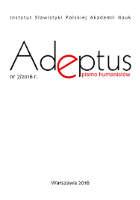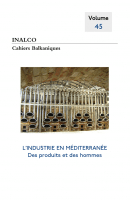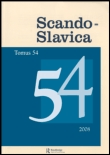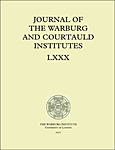
Studia Slavica et Balcanica Petropolitana
metrics 2024
Exploring the Depths of Slavic and Balkan Heritage
Introduction
Studia Slavica et Balcanica Petropolitana is an esteemed open-access journal, published by the Department of History at St. Petersburg State University, focusing on interdisciplinary research within the fields of Slavic and Balkan studies. Since its inception in 2007, the journal has made significant contributions to the academic discourse surrounding historical and contemporary issues pertinent to these regions, thus achieving a strong reputation among scholars. As of 2023, it is categorized in the Q2 quartile for History, ranked 873 out of 1760 in the arts and humanities segment, highlighting its impactful scholarly contributions. The journal operates out of Russia, with its editorial office located at Mendeleevskaya Liniya in St. Petersburg. Its accessible publishing model promotes widespread dissemination of knowledge, making it an invaluable resource for researchers, professionals, and students who aim to deepen their understanding of Slavic and Balkan societies from both historical and modern perspectives.
Metrics 2024
 0.18
0.18 -
- 0.10
0.10 5
5Metrics History
Rank 2024
Scopus
IF (Web Of Science)
JCI (Web Of Science)
Quartile History
Similar Journals

Heranca-Revista de Historia Patrimonio e Cultura
Exploring the Depths of Heritage and CultureHerança - Revista de História, Patrimonio e Cultura is a distinguished academic journal published by Ponteditora in Portugal, dedicated to the exploration and preservation of history, heritage, and culture. Since its inception in 2018, this open-access journal has established a strong foothold in the academic community, becoming a valuable resource for researchers, professionals, and students alike. With an impressive presence in the Scopus rankings—ranking Q3 in multiple categories such as *Arts and Humanities (Miscellaneous)* and *Cultural Studies*—the journal demonstrates its commitment to advancing interdisciplinary dialogue and fostering innovation in the humanities. By offering unrestricted access to its rich array of scholarly articles, Herança plays a vital role in disseminating knowledge and promoting further research in the fields of history, museology, and the arts. With an aim to bridge theoretical insights and practical applications, this journal stands as an essential contributor to the cultural landscape and heritage studies, making it a pivotal platform for contemporary issues in our understanding of cultural identity and heritage conservation.

Slavia Meridionalis
Unveiling new perspectives in Slavic academic discourse.Slavia Meridionalis is a distinguished open-access journal published by the Polish Academy of Sciences, Institute of Slavic Studies, dedicated to advancing scholarly discourse in the fields of Anthropology, Cultural Studies, History, Linguistics and Language, and Literature and Literary Theory. With its ISSN 1233-6173 and E-ISSN 2392-2400, this journal has made significant strides in promoting research since its inception in 2014. Operating from Warsaw, Poland, Slavia Meridionalis aims to serve as a pivotal platform for researchers and students alike, fostering interdisciplinary collaboration and knowledge dissemination. The journal holds respectable rankings in its various categories, some achieving Q3 status, which reflects its commitment to quality scholarship within the academic community. By providing open access to its readership, Slavia Meridionalis ensures that pivotal research is readily available for the global audience, thus enhancing its relevance and impact across diverse fields.

Kunstiteaduslikke Uurimusi
Bridging Disciplines Through Art AnalysisKunstiteaduslikke Uurimusi is a notable academic journal published by the Estonian Society Art Historians, dedicated to the exploration and analysis of art and cultural studies within the vibrant context of Estonia and beyond. With an ISSN of 1406-2860, this journal offers a platform for researchers, professionals, and students to disseminate their findings and engage in meaningful discourse in the fields of Arts and Humanities and Cultural Studies. Although it occupies a fourth quartile ranking in both fields, the journal's commitment to fostering scholarly dialogue is evident through its open access provision, facilitating the sharing of knowledge across disciplines. Covering a broad spectrum of art historical themes since its inception, Kunstiteaduslikke Uurimusi aims to contribute to the understanding of artistic practices and cultural phenomena, making it an essential resource for those interested in the intersections of art, culture, and society. The journal continues to evolve, with coverage extending from 2011 to 2024, reflecting the dynamic nature of the arts and cultural sectors.

Adeptus
Advancing Slavic Studies Through Open DialogueAdeptus is a pioneering open-access journal published by the Polish Academy of Sciences, Institute of Slavic Studies, specializing in Slavic studies and cultural research. Since its inception in 2014, the journal has aimed to foster scholarly dialogue and advance knowledge across various disciplines related to Slavic languages, literature, history, and sociology. With an ISSN of 2300-0783, Adeptus has positioned itself as a vital resource for researchers, professionals, and students engaged in Slavic studies, offering a platform for high-quality, peer-reviewed articles that explore diverse topics within the field. The journal's open-access model promotes accessibility and dissemination of knowledge, making it a significant contributor to the academic landscape. Located in Warsaw, Poland, Adeptus continues to thrive as a key outlet for innovative research, inviting submissions that embody rigorous scholarship and insightful perspectives.

Cahiers Balkaniques
Connecting Scholars to the Heart of the BalkansCahiers Balkaniques is a distinguished academic journal dedicated to the study of Balkan languages, cultures, and civilizations, published by the Institut National des Langues et Civilisations Orientales (INALCO). Since its inception in 2004, it has embraced an Open Access model, facilitating unrestricted access to its research articles, making it a vital resource for scholars and professionals in the fields of linguistics, cultural studies, and regional history. With ISSN 0290-7402 and E-ISSN 2261-4184, Cahiers Balkaniques serves as a crucial platform for disseminating research that explores the rich and diverse heritage of the Balkan region. Researchers, students, and professionals alike benefit from its commitment to fostering understanding and dialogue around the intricate social, political, and linguistic dynamics of the Balkans, solidifying its importance within the academic community.

Konstantinove Listy-Constantines Letters
Advancing interdisciplinary dialogue in history, philosophy, and religion.Konstantinove Listy - Constantines Letters is a premier academic journal published by the Constantine Philosopher University in Nitra, Slovakia. With a focus on the interdisciplinary exploration of historical, philosophical, and religious studies, this journal has established itself as a significant platform for scholarly discourse since its inception in 2015. The journal's impressive rankings—Q1 in History and Religious Studies, along with Q2 in Philosophy—demonstrate its commitment to high-quality research, concurrent with its strong performance in Scopus rankings, placing it in the 80th percentile for both Religious Studies and History disciplines. As an integral part of the academic landscape, Konstantinove Listy invites researchers, professionals, and students alike to contribute to its mission of advancing knowledge and understanding in these vital fields. While the journal operates under traditional publishing, it is recognized for its accessibility and contribution to fostering a vibrant scholarly community.

Scando-Slavica
Illuminating the Rich Tapestry of Scandinavian and Slavic ScholarshipScando-Slavica is a renowned academic journal published by ROUTLEDGE JOURNALS, TAYLOR & FRANCIS LTD, specializing in the rich interplay of Scandinavian and Slavic studies. With its ISSN 0080-6765 and E-ISSN 1600-082X, the journal has been a critical resource for scholars since its inception in 1954, covering a wide range of disciplines including archaeology, cultural studies, history, linguistics, and literature. As of 2023, it has consistently ranked in the third quartile across various categories, indicating its influential role in disseminating innovative research within the arts and humanities. With a focus on interdisciplinary dialogue, Scando-Slavica aims to foster a deeper understanding of cultural exchanges and linguistic connections, making it an essential read for researchers, professionals, and students interested in exploring the complexities of Nordic and Slavic interactions. While currently not an open access journal, its contributions have garnered substantial citations, bolstering its academic impact and relevance in a diverse scholarly landscape.

ZEITSCHRIFT FUR SLAVISCHE PHILOLOGIE
Connecting Cultures through Language StudiesZEITSCHRIFT FUR SLAVISCHE PHILOLOGIE is a pivotal journal in the field of Slavonic philology, published by Universitatsverlag C Winter Heidelberg GmbH. Renowned for its scholarly rigor and insightful contributions, this journal serves as a key platform for researchers, professionals, and students interested in Slavic languages and linguistics. Despite its classification as a traditional subscription journal, it has maintained a consistent presence in the academic community with contributions that enhance understanding of linguistic, cultural, and literary studies within the Slavic context. With an H-index reflecting its impact and relevance, the journal has historically been indexed in Scopus, ranking in the 34th and 33rd percentiles within the Arts and Humanities and Social Sciences categories, respectively. The journal has featured a range of scholarly articles from 2002 to 2017, providing a rich repository of knowledge for those dedicated to the study of Slavic languages. For any researcher aiming to delve into this dynamic field, ZEITSCHRIFT FUR SLAVISCHE PHILOLOGIE remains an essential resource.

JOURNAL OF THE WARBURG AND COURTAULD INSTITUTES
Advancing Critical Discourse in Art HistoryWelcome to the JOURNAL OF THE WARBURG AND COURTAULD INSTITUTES, a distinguished scholarly publication dedicated to the study of art history, cultural studies, and the interconnections between visual arts and intellectual history. Established in 1964 and published by the Warburg Institute, this journal serves as a vital platform for innovative research and interdisciplinary scholarship. Although it currently holds a Q4 ranking in both Arts and Humanities (Miscellaneous) and Cultural Studies, the journal is committed to fostering critical discourse that transcends conventional boundaries. With an ISSN of 0075-4390 and an E-ISSN of 2044-0014, the journal provides accessible insights for researchers, professionals, and students interested in the evolving landscape of cultural heritage studies. While the journal is not currently open access, its contributions are invaluable for those seeking to deepen their understanding of the intricate relationship between culture and the arts. We invite you to explore the journal's rich archive and engage with the latest academic dialogues shaping the field.

Radovi Instituta za Povijest Umjetnosti-Journal of the Institute of Art History
Advancing Knowledge in Visual and Performing Arts.Radovi Instituta za Povijest Umjetnosti-Journal of the Institute of Art History is a distinguished academic journal dedicated to the exploration and critical analysis of art history, with a special emphasis on the visual arts and performing arts. Published by INST POVIJEST UMJETNOSTI-INST ART HISTORY in Croatia, this journal provides an essential platform for researchers and practitioners to disseminate their findings and engage in scholarly discourse. Since its transition to Open Access in 2008, it has significantly increased the accessibility of its content, fostering a global exchange of ideas. The journal is indexed in notable databases, reflecting its impact within its field, with a current ranking that places it in the Q4 category for History and in Q3 for Visual Arts and Performing Arts. As it spans its converged years from 2015 to 2024, Radovi is poised to expand its influence and continue contributing to the understanding of art historical narratives. Researchers, professionals, and students alike will find this journal a valuable resource for contemporary discussions and theoretical advancements in the study of art.